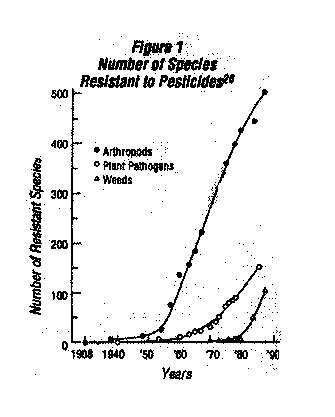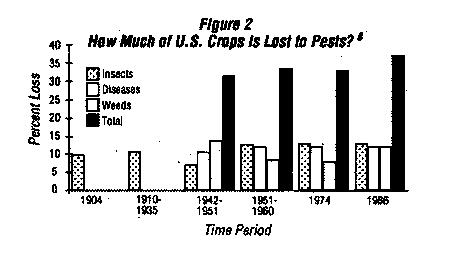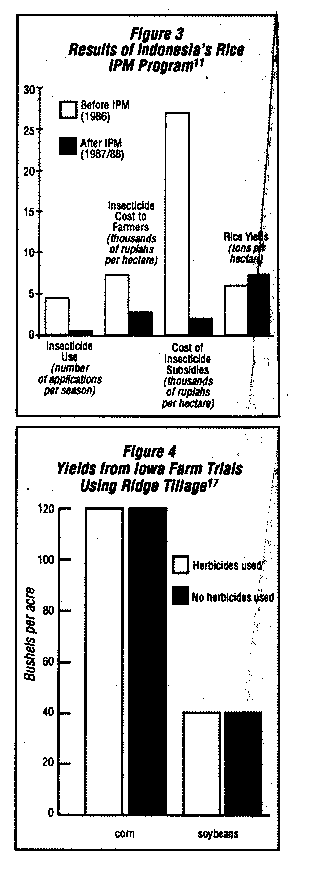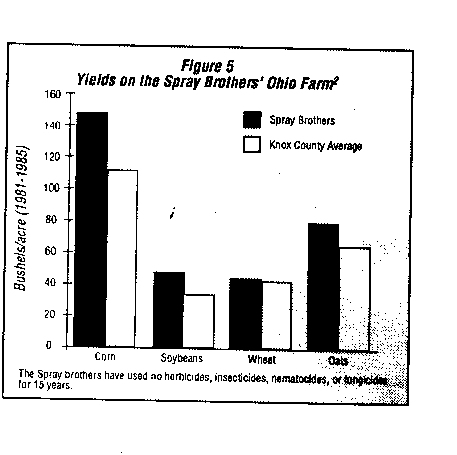
JPR Index | Virtual Library | Magazine Rack | Search
By Susan Cooper
How often have you heard or read that the pesticides are essential? That without the widespread release of these toxic materials into the environment we would be unable to feed a hungry world? That the benefits of pesticides outweigh their risks? Despite gloomy forecasts by pesticide manufacturers, and even some farmers, there is strong evidence that an adequate and healthful food supply can be produced without our heavy reliance on chemical pesticides. This article will take a brief look at the U.S. Environmental Protection Agency's (EPA's) regulatory shortcomings with regard to benefits, some of the many inroads into the supposed benefits, and a few snapshots of non-chemical grower success stories that demonstrate that we can have a productive, sustainable farming future, free from agriculture's current pesticide addiction
According to the federal law which regulates the use of pesticides, the Federal Insecticide Fungicide and Rodenticide Act (FIFRA), EPA is required to examine the benefits of a pesticide before it is registered. In practice, they do no formal analysis of the benefits prior to registration, despite the fact that all pesticides have attendant risks. Instead, "EPA has assumed that an applicant's willingness to expend the sums required to obtain registration of a pesticide, in the expectation of recovering those sums by sales of the pesticide, indicates that the pesticide's use will yield benefits that are greater than negligible.
When evidence of extraordinary environmental contamination or potential health risk accumulates for a registered pesticide, EPA then initialed the "Special Review" process to formally examine both risks and benefits. However, according to the National Academy of Sciences (NAS), "Formal benefits assessments ... do not generally contain detailed economic analyses of alternative nonchemical or IPM strategies. The effect of this practice is to assume that the economic value of nonchemical or integrated control strategies is near zero. Consequently, the benefits assessments tend to overstate the economic benefits.7
Thus the supposed benefits of pesticides are largely assumed rather than calculated, and when calculated are generally exaggerated.
What are some of the factors that interfere with the rosy view of pesticide addicts? Applying pesticides to the environment often has unintended, indirect effects. In agriculture, side effects which impact production include: the development of pest resistance, secondary pest outbreaks and pest resurgence, impacts on pollinators, and changes in the cropping system.
Pesticide resistance is a predictable consequence of repeated pesticide use.4 (see Figure 1.) In many cases, pest resistance has resulted in more frequent spraying, followed by increasing resistance and escalating crop losses, a cycle often called the pesticide treadmill as growers spray as fast as they can and still lose "round.

Many beneficial organisms, from predatory insects to parasitic wasps, are more susceptible to pesticides and develop resistance far more slowly than do pests. As a result, spraying for one pest can result in outbreaks of other pests as naturel enemy populations are devastated and therefore cannot keep the prey in check. This is called a secondary pest outbreak. Twenty-four of the 25 pests causing at least $1 million worth of crop damage in California in 1970 were secondary pests, 5 including spider mites, lygus bugs, codling moth`, and cotton bollworm, and this situation remains largely unchanged:
Not only are many insecticides devastatingly poisonous to honeybees, but the widespread use of herbicides combined with extensive monoculture often has serious impacts on bees by eliminating important pollen sources. For example, the use of fenitrothion in New Brunswick blueberry fields coincided with a 665 tonne/year reduction in production linked to a shortage of bees for pollination.7 Overall, Pimentel, an entomologist at Cornell University, and his colleagues estimate that honeybee poisonings and reduced pollination due to pesticide use now cost at least $150 million annually.8
The introduction of a pesticide may result in changes in the cropping system which can ultimately cause more pest problems. Approximately 4045 percent of U.S. corn is grown without rotations, 9 a situation facilitated and encourages by pesticides. As a result, insecticide use on corn has grown more than 1000 -fold since the 1940s while losses to insects have climbed from 3.5 percent to 12 percent, primarily due to the abandonment of crop rotations.8
The complex problems associated with over-reliance on pesticides has often been masked by changes in other aspects of production. However, the critical examination of pest losses by Pimentel documents that the percentage of crop losses to pests is climbing beyond pre-intensive-pesticide era levers, for insects, weeds and disease.(See Figure 2.) These figures indicate that our current reliance on pesticides is probably not a viable long-term strategy.

To those that claim that our food needs cannot be met without a heavy reliance on pesticides perhaps the best reply is that people across the United States and around the world are growing productively while reducing or eliminating their use of pesticides.
IPM In Indonesian Rice: The Rise and Fall of the Brown Planthopper During the 1970s the Indonesian government launched a campaign to reverse rising dependence on rice imports. They strove forward to self-sufficiency through a complex "green revolution" package that included high yielding rice varieties, elimination of rotations and multiple cropping, irrigation, pricing policies, and extensive subsidization of pesticides and fertilizers. But the frequent applications of broad spectrum pesticides devastated the naturel predators, resulting in massive outbreaks of the rice brown planthopper, Nilapanuata lugens . From 1977 to 1979 over 2 million hectares of rice were lost to brown plant-hoppers. Resistant rice strains were introduced allowing yields to temporarily recover, but the hoppers were soon back and, by 1985, 70 percent of Java's rice was threatened with destruction.
Fortunately, the story has a happy ending. A great deal of research had been clone from 1977 to 1985 indicating that "rice brown planthopper was a pest because of, not in spite of, insecticide applications." By 1986 a pilot integrated pest management (!PM) program had been established to move farmers away from calendar applications and toward the protection of naturel enemies. The program worked so well that on November 5, 1986, President Suharto declared IPM the national pest control strategy for rice, banned 57 of the most widely used insecticides, drastically reduced pesticide subsidies, and instigated a massive IPM education program for farmers. Insecticide use dropped 90 percent, farm profitability climbed, and production increased. (See Figure 3.) The Food and Agriculture Organization (FAO), one of the many agencies responsible for the green revolution package, summarized it very well, "insecticides were always bundled together with these other inputs, but conclusive studies showing their contributions to production were not made "

Sweden: 50 percent Reduction In Pesticide Use in 5 Years: In 1985, prompted by concerns over human health and environmental impacts, Sweden established a national goal to reduce the use of pesticides in agriculture by 50 percent. By the end of 1990, in only 5 years, they met their goal. According to Sweden's National Board of Agriculture, two-thirds of the reductions are attributable to longer doses of traditional herbicides. Indeed, research at the University of Agricultural Sciences in Uppsala, Sweden indicate that the best yields are obtained at half the recommended herbicide dose and at 80 percent herbicidal efficiency. Sweden was so pleased with its success that on June 9, 1990, the swedish parliament passed a bill establishing another 50 percent reduction goal to be reached by the mid l990s.
US. Sustainable Agriculture, Envi-able Yields: In the last five years, Iowa farmers concerned about farm profitability have started banding together and, with the help of the Iowa State University, they are doing research on reducing inputs. The Practical Farmers of Iowa (PFI) cooperators found that using ridge tillage provides excellent yields without herbicides.16 (See Figure 4.) In fact, because yields were equivalent while costs were significantly higher for herbicide treatments, the net benefit from herbicides was negative: -$2.26 to -$10.91 per acre of corn and -$1.97 to -$32.84 per acre for soybeans. l7
But the PFI cooperators are by no means the only growers working successfully at sustainable productivity. The Kitamuras farm 305 acres north of Sacramento, California, 160 acres of which are planted in processing tomatoes. Conventional processing tomatoes are one of the most chemical intensive crops because of normally severe insect, disease and nematode problems--in 1984, California tomato growers applied 3.7 million pounds of fungicides, 492,000 pounds of insecticides, 89,000 pounds of herbicides, and 1.7 million pounds of nematocides in total of 16,943 applications. But the Kitamuras, through an intensive IPM program, crop rotation, innovative irrigation to prevent disease, and resistant varieties, have managed to keep yields good while greatly reducing chemical inputs. In 1986, NRC explains that "The Kitamuras reported spending a total of $1,482 on pest control, with a savings of $7,318--an average of $45.73 per acre," compared to the estimated $8,800 cost of "a conventional pesticide-based control program using manufacturers' recommended application rates.. Yet, the farm's 19&6 average yield--35.5 tons per acre versus the [Colusa] county average of 29.2 tons per acre--was characterized as outstanding.
Conventional orchard crops, including nuts and fruits, are typically insecticide intensive. Lonnie Hendricks, a University of California extension agent, has been working with almond growers to help farmers reduce their pesticide use. Peach twig borer (PTB) and navel orangeworm together account for about half the nut rejects in commercial almond sales. Hendricks has found that with removal overwintering mummies, protection of beneficials, proper irrigation, and good cover crop management, high quality crops can be grown without insecticides. In fact, "vetch cover without pesticide use seemed to be the best treatment for PTB. Thus growers were able to eliminate or drastically reduce pesticide use while improving pest control.

Rex and Glen Spray, two brothers from Ohio, diversely farm 720 acres with a four year rotation including corn, soybeans/adzuki beans, wheat or oats, and red clover, as well as 32 dairy and 40-50 beef cattle. According to the NRC, "Insecticides, nematocides, and fungicides have not been used on the Spray Brothers farm in 15 years. The brothers stated emphatically that they did not have serious infestations of in sects or diseases. The current and consistently high yields they obtain suggest that they are correct in their assumption. In deed, their yields are well above County averages (see Figure 5), Their profits are very good; the partnership income in 1985 was $206,650 without any government 6 subsidies.20
Innovative farmers and ranchers across the country are reducing and eliminating their use of toxic pesticides, and they are doing it with strong yields and solid profits. Moving mainstream agriculture away from its pesticide addiction is going to be a long, hard battle, but it can be done. Resourceful, successful growers~and governments, like the on es in this article, are setting examples for all to follow. Chemically intensive production is only 45 years old in an agricultural history that goes back more than 2000 years. Alternative production methods hold the best trope of sustained production not just for the next 40 years, but for the next 4000.
1. U.S. Environmental Protection Agency. 1988. Regulation of pesticides in foods: Addressing the Delaney paradox. Federal Register 53 (October 19):41104-41123.
2. National Research Council, Board on Agriculture, Committee on the Role of Alternative Farming Methods In Modem Production Agriculture. 1989. Alternative agriculture. Washington, D.C.: National Academy Press, p. 218
3.National Academy of Sciences. 1986. Pesticide resistance Strategies and tactics for management. Washington, D.C.: NAS Press.
4. Mueller-Beilschmidt, Doria. 1991. Resistance of Insect pests and disease vectors to synthetic pyrethroids. Journal of Pesticide Reform 10(4).34-38.
5Luck, RF., R van den Bosch, and R Carcia. 1977. Chemical Insect control--a troubled pest management strategy. Bioscience 27(9): 606-61 .
6.Luck, Robert, personal communication, 1991.
7. Kevan, Peter G., E. Ann Clark, and Vernon G. Thomas. 1990. Insect pollinators and sustainable agriculture. American Journal of Alternative Agriculture 5(1): 13-22
8. Pimentel, David, et al. 1991. Environmental and economic impacts of reducing U.S. agricultural pesticide use. In D. Pimentel and A Hanson (eds.) CRC Handbook of Pest Management in Agriculture. Boca Raton, FL: CRC Press, Inc.
9. Reference #2, p. 139.
10. Reference # 9, p. 682.
11.United Nations, Food and Agriculture Organization. 1988. Integrated pest management In rice In Indonesia: Status after three crop seasons, perspectives for farmers training. Jakarta, Indonesia: FAO.
12. Presidential Instruction 3 of 1986 (Inpres 3/1986). Cited In reference #11.
13. References on problems with the «green revolution» Include: Ehrlich, P.R., A.E. Ehrlich, and J.P. Holden. 1977. Ecoscience: Population, resources, environment. San Francisco, CA: W.H. Freeman and Paddock, William C. 1970. How green Is the green revolution? Bioscience 20 897-900
14. Weinberg, A.C. 1990. Reducing agricultural pesticide use In Sweden. Journal of soil and Water Conservation 45 (November/December): 61~613.
15. Swedish National Board of Agriculture. 1990. Measurement for the program to reduce the risks to environment and health when using pesticides. Rpt. No. 8 (In Swedish). Cited in reference #14.
16.Practical Farmers of Iowa. 1989. Annual membership meeting: Summary of 1989 on-farm experimental results. Ames, IA.
17.Reference #2, p. 384-386.
18.Beane, K and W. Olkowski. 1991. Cover crops and biological control in California almonds: case histories. IPM Practitioner 13(4):.
19.Reference #2, p. 260.
20.Holt, Jodie S. and H.M. LeBaron. 1990. Significance and distribution of weed resistance. Weed Technology 4(1): 141-149.
Citation for this article : Cooper, Susan 1991, "Will the world starve without pesticides?", Journal of Pesticides Reform, Vol. 11, No. 2, Spring 1991, pp.2-4.
Copyright © 1991 Northwest Coalition for Alternatives to Pesticides.
Reprinted with permission.
Info Request | Services | Become EAP Member | Site Map
Give us your comments about the EAP site
Ecological Agriculture Projects, McGill University (Macdonald
Campus)
Ste-Anne-de-Bellevue, QC, H9X 3V9 Canada
Telephone:
(514)-398-7771
Fax:
(514)-398-7621
Email: info@eap.mcgill.ca
To report problems or otherwise comment on the structure of this site, send mail to the Webmaster